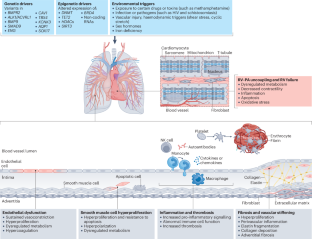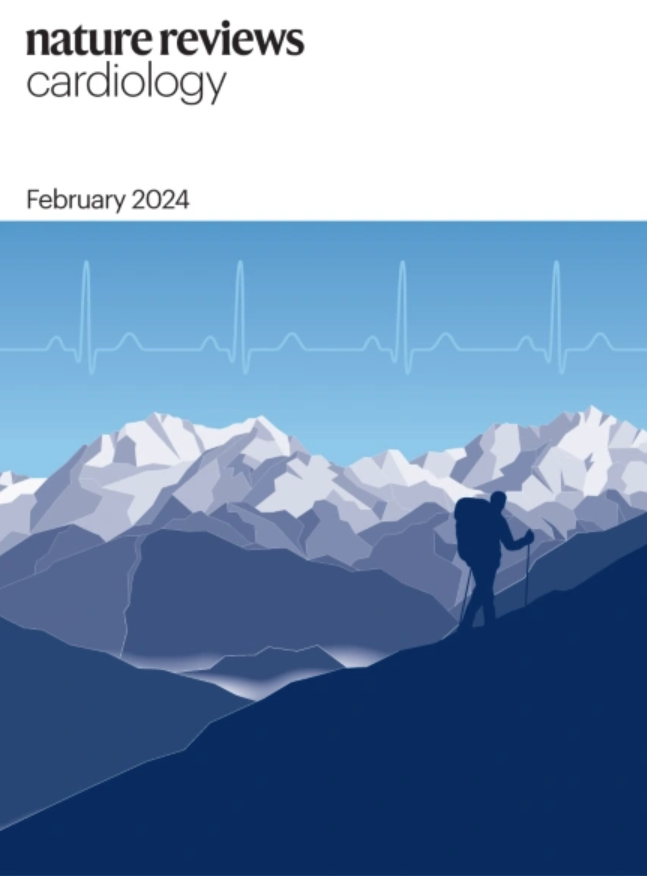肺动脉高压的机制和治疗
IF 41.7
1区 医学
Q1 CARDIAC & CARDIOVASCULAR SYSTEMS
引用次数: 0
摘要
在过去的 25 年中,肺动脉高压(PAH)的治疗取得了长足的进步,但这种疾病仍然会危及患者的生命。现有的 PAH 疗法大多局限于通过纠正血管活性因子的失衡来缓解症状。酪氨酸激酶抑制剂伊马替尼是第一种在 PAH 患者中进行测试的主要非血管扩张药物,与安慰剂相比,它能改善患者的运动能力和肺血流动力学,但却以硬膜下血肿等不良反应为代价。鉴于吸入给药可降低全身不良反应的风险,酪氨酸激酶抑制剂的吸入制剂目前正在临床开发中。其他治疗 PAH 的新方法包括使用索他特停(sotatercept)抑制激活素受体 IIA 型信号传导,该药物在临床试验中已显示出显著疗效,并于 2024 年获准在美国使用,但该药物的长期安全性仍不明确。PAH 治疗的未来进展将以右心室功能为重点,并涉及深度表型分析和个性化医疗方法的开发。在本综述中,我们总结了 PAH 的基本机制,概述了现有 PAH 疗法及其局限性,介绍了目前正在进行 II 期或 III 期临床试验的以非扩张血管为主的新型药物的发展情况,并讨论了 PAH 研究的未来方向。本文章由计算机程序翻译,如有差异,请以英文原文为准。


Mechanisms and treatment of pulmonary arterial hypertension
Substantial progress has been made in the management of pulmonary arterial hypertension (PAH) in the past 25 years, but the disease remains life-limiting. Established therapies for PAH are mostly limited to symptomatic relief by correcting the imbalance of vasoactive factors. The tyrosine kinase inhibitor imatinib, the first predominantly non-vasodilatory drug to be tested in patients with PAH, improved exercise capacity and pulmonary haemodynamics compared with placebo but at the expense of adverse events such as subdural haematoma. Given that administration by inhalation might reduce the risk of systemic adverse effects, inhaled formulations of tyrosine kinase inhibitors are currently in clinical development. Other novel therapeutic approaches for PAH include suppression of activin receptor type IIA signalling with sotatercept, which has shown substantial efficacy in clinical trials and was approved for use in the USA in 2024, but the long-term safety of the drug remains unclear. Future advances in the management of PAH will focus on right ventricular function and involve deep phenotyping and the development of a personalized medicine approach. In this Review, we summarize the mechanisms underlying PAH, provide an overview of available PAH therapies and their limitations, describe the development of newer, predominantly non-vasodilatory drugs that are currently being tested in phase II or III clinical trials, and discuss future directions for PAH research. In this Review, Ghofrani and colleagues discuss the mechanisms underlying the development of pulmonary arterial hypertension, provide an overview of approved therapies and describe the predominantly non-vasodilatory drugs that are currently being tested in clinical trials.
求助全文
通过发布文献求助,成功后即可免费获取论文全文。
去求助
来源期刊

Nature Reviews Cardiology
医学-心血管系统
CiteScore
53.10
自引率
0.60%
发文量
143
审稿时长
6-12 weeks
期刊介绍:
Nature Reviews Cardiology aims to be the go-to source for reviews and commentaries in the scientific and clinical communities it serves. Focused on providing authoritative and accessible articles enriched with clear figures and tables, the journal strives to offer unparalleled service to authors, referees, and readers, maximizing the usefulness and impact of each publication. It covers a broad range of content types, including Research Highlights, Comments, News & Views, Reviews, Consensus Statements, and Perspectives, catering to practising cardiologists and cardiovascular research scientists. Authored by renowned clinicians, academics, and researchers, the content targets readers in the biological and medical sciences, ensuring accessibility across various disciplines. In-depth Reviews offer up-to-date information, while Consensus Statements provide evidence-based recommendations. Perspectives and News & Views present topical discussions and opinions, and the Research Highlights section filters primary research from cardiovascular and general medical journals. As part of the Nature Reviews portfolio, Nature Reviews Cardiology maintains high standards and a wide reach.
 求助内容:
求助内容: 应助结果提醒方式:
应助结果提醒方式:


